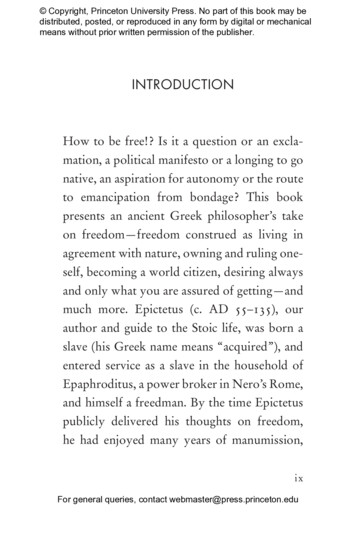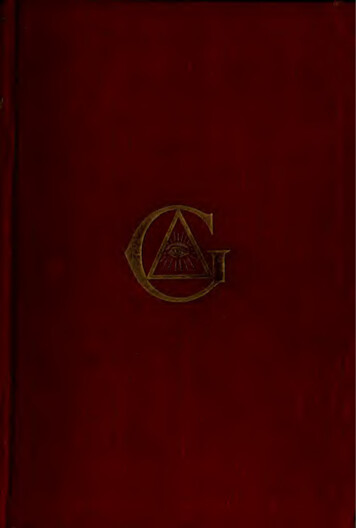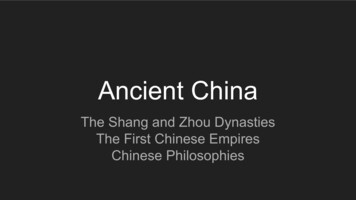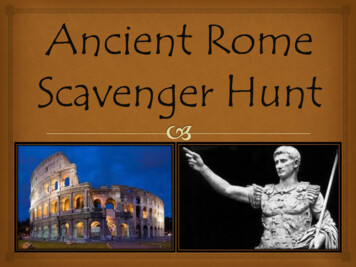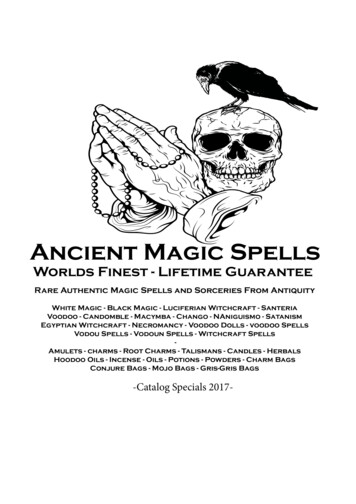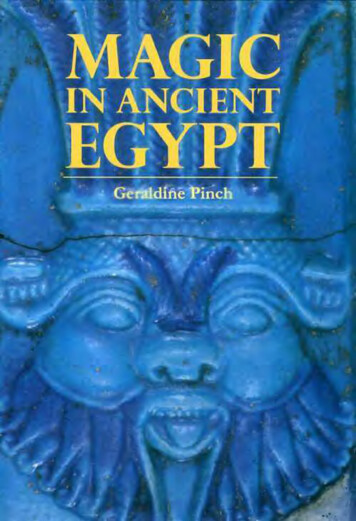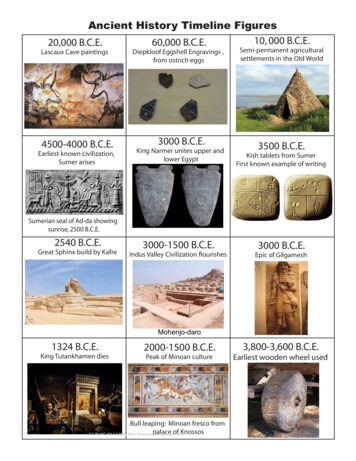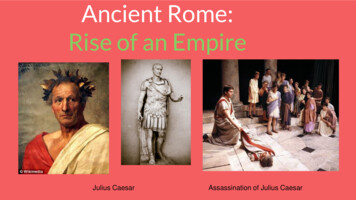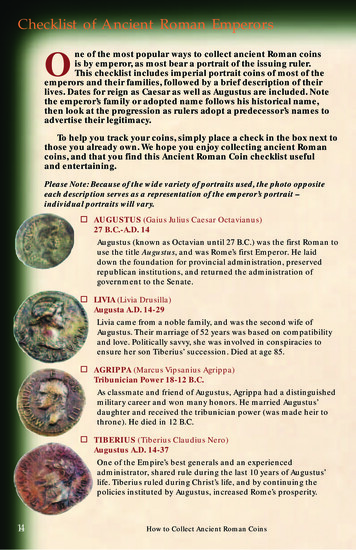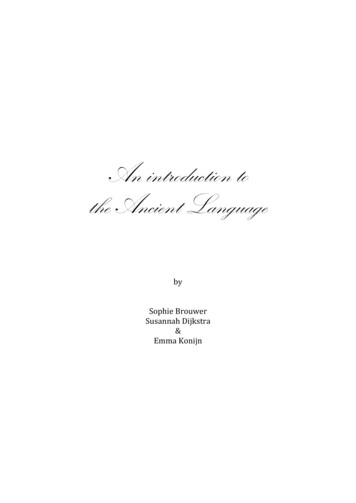
Transcription
An introduction tothe Ancient LanguagebySophie BrouwerSusannah Dijkstra&Emma Konijn
Contents1. Introduction.32. Phonetics & Phonology .42.1 Phonetics .42.1.1 Consonants .42.1.2 Vowels .42.1.3 Syllable structure .52.2 Phonology .52.2.1 Phonological processes .52.2.2 Stress .52.2.3 List of pronunciation of some words.53. A Grammar Guide to the Ancient Language .63.1 Nouns .63.1.1 Gender .63.1.2 Plurals .63.1.3 Articles .73.1.4 Compound words .73.1.5 Diminutive forms .73.1.6 Negotiation .83.2 Pronouns .83.2.1 Personal pronouns.83.2.2 Possessive pronouns .93.2.3 More on possessiveness .93.2.4 Reflexives. 103.2.5 Demonstrative pronouns. 103.2.6 Interrogatives. 113.2.7 Indefinite pronouns . 123.3 Adjectives . 123.3.1 General information and word order . 133.3.2 Degree – comparatives and superlatives . 133.3.3 A small notion on some suffixes . 143.4 Titles, ancestry and honorifics . 151
3.5 Numerals . 173.6 Prepositions . 183.7 Adverbs . 183.7 Verbs . 193.7.1 Agreement . 193.7.2. Tense. 203.7.3 The verb “to be” . 213.7.4 The passive . 223.7.4 The subclause . 223.7.5 Other important verbs. . 233.7.6 Negotiation . 233.7.7 A small notion on derivation. 233.8 Spells, wishes and other special formulations . 244. Examples of the Ancient Language in the Elvish Culture . 274.1 “Du Silbena Datia” . 274.2 A letter to Eragon and Saphira . 284.3 An elvish greeting . 295. A Basic Dictionary . 305.1 Christopher Paolini’s Ancient Language . 305.2 Additional vocabulary . 376. An Evaluation of the Ancient Language . 432
1. IntroductionKvetha fricai maerr,Hereby, we present the first grammar of the Ancient Language from the Inheritance Cycle byChristopher Paolini. His books take place in the mystical land of Alagaësia, where elves, dragons,dwarves, humans and every other kind of magical creatures can be found. Nowadays, only theelves, dragons and some humans master and use the Ancient Language. Once this language wasthe language of all creatures in Alagaësia. Unfortunately, it started to die out.The Grey Folk, however, somehow managed to tie the language to their magic, as a tool forregulating their powers. Significantly, it is impossible to lie in the Ancient Language; everythingsaid in this tongue is irrevocably true. As a result, most of the original material from the booksare spells and phrases commonly used in official, formal ceremonies. The bigger one’sknowledge of the Ancient Language, the more spells one possesses and the more power theyhave.During the creation of the language Christopher Paolini found the word ‘brisingr’ for fire in anOld Norse dictionary. He loved the word so much (and so do we), he decided to pull many more(if not most) of the lexicon of the Ancient Language from Old Norse. In addition, he pulled therest of the lexicon from his imagination. For the grammar on the other hand, he chose English ashis muse, which is not surprising, since English is Paolini’s mother tongue. The combination ofOld Norse and English proves to be an interesting one as will discover when attempting to learnthis fantasy language.We, as editors and expanders, were up for the challenge when this assignment was handed tous in our Interlinguistics class at the University of Amsterdam taught by prof. Dr. FredericoGobbo. We hope that this first version of the grammar of the Ancient Language will satisfy,clarify, and most of all help one get into closer touch with this fantastical, mystical world.The Editors3
2. Phonetics & PhonologyThis chapter contains the basic phonology of the Ancient Language.2.1 Phonetics2.1.1 ConsonantsThe ancient language has a consonant inventory consisting of 23 consonants. It has sixplosive phonemes, of which the /p/ is very rare word-initially. It occurs in the word pomnuria,which is formal possessi e pronoun. The b does not occur between owels. The sibilant s/only occurs when followed by /il/, otherwise it will show as an /s/. The following 23 consonantsexist in the Ancient Language.BilabialLabiodentalDentalAlveolar lantGlottalsFricativefvθ ðszApproximantrLaterallʃ ʒHjw2.1.2 VowelsAll vowels can occur short or long, depending on stress. Stressed vowels are longer, whereasunstressed vowels are short.Front ralBack VowelsUnroundedRoundeduə4
Open-midɛɔOpenaɑThe Ancient Language has several diphthongs. /a /, /e /2.1.3 Syllable structureA nucleus is obligatory in the Ancient language. Words cannot occur without a nucleus. Theonset and coda are both optional, and both used frequently.2.2 Phonology2.2.1 Phonological processesThe ancient language has several phonological processes. One of the most importantprocesses in the lowering of the /e/. The /e/ will lower itself into an /ɛ/ when followed byliquidae. If we compare ebrithil /ebriθ l/ to elrun /ɛlrun/ we can clearly see the lowering of thefirst vowel. This lowering will happen also when the /e/ is followed by an /r/.Another, less frequent process is the dentalization of the /s/ before /il/. This will turn the /s/into an /s/.2.2.2 StressIn the Ancient Language, lexical stress is phonemic. Stressed syllables are longer than nonstressed syllables, and are also higher in pitch and a bit louder. Stress falls mostly on theantepenultimate syllable, unless, of course, a word consists of only one or two syllable. There areseveral exceptions of this rule, where the stress falls on the penultimate syllable instead of theantepenultimate. This happens mostly when words consist of three syllables. One of theseexceptions is esterna, where the stress comes on the second syllable, e.g /ɛstɛ’rna .2.2.3 List of pronunciation of some wordsAlagaësia: /aləɡe zia/Skullblaka: /skulblaka/Adurna /adurna/Andlát: /ɑntla:t/Ebrithil : /ebriθ l/Elrun Ona: /ɛlrun o:na/Brisingr: /br s ŋɡərDauthdaert: /da θda:rt5
3. A Grammar Guide to the Ancient LanguageThis chapter contains a basic grammar guide of the Ancient Language. Many topics can beelaborated, but for now this is perfect to get an idea of this language.The Ancient Language is on most points relatively easy – especially for the English speakingworld (and therefore most English speaking actors!). It follows the word order and many othercontractions from English. When one knows the basis, this makes it definitely easier to speakand to expand the language.3.1 Nouns3.1.1 GenderNouns do not have morphologically visible genders. Any information concerning the genderof an entity, for example a kona “woman”, can be deri ed from the semantics or from the context,like in the case of skulblaka “dragon”, which is a gender-neutral word from the semantic point ofview although dragons definitely have genders.Consequently, the way you perceive the entity determines the pronoun. Kona is referred towith a feminine pronoun, madr “man” with a mascul
3 1. Introduction Kvetha fricai maerr, Hereby, we present the first grammar of the Ancient Language from the Inheritance Cycle by Christopher Paolini.
